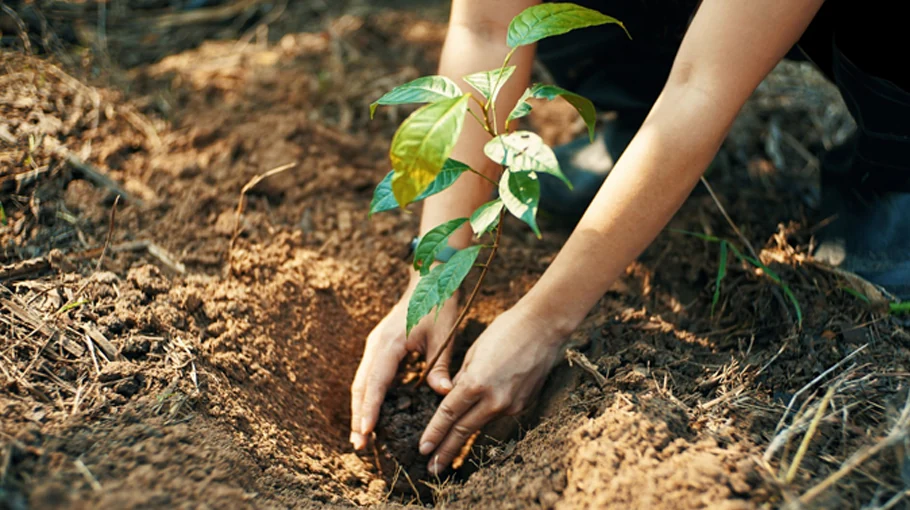In today’s fast-paced world, the pursuit of sustainability is crucial. Expert tree planting techniques can enhance musical spaces and provide numerous environmental and psychological benefits. Trees not only add visual appeal to these areas but also contribute to the well-being of individuals.
This article explores the concept of tree planting techniques and the green advantages they bring to musical spaces. By strategically selecting and planting trees, we can create harmonious environments that foster music and improve overall well-being.
Through proper tree selection, planting methods, and maintenance practices, we can optimize the musical experience. By harnessing the power of nature, we can inspire creativity, improve acoustics, and cultivate tranquility for musicians and audiences alike.
Key Takeaways
- Proper tree selection and planting techniques can greatly enhance the acoustic qualities of musical spaces.
- Soil preparation, such as assessing composition and drainage, is crucial for successful tree planting.
- Optimal tree growth can be achieved through techniques like wide and shallow hole digging, correct planting depth, and mulching.
- Care and maintenance of newly planted trees, including watering, mulching, pruning, and pest monitoring, are essential for their long-term health and vitality.
The Importance of Proper Tree Planting Techniques
Proper tree planting techniques play a crucial role in ensuring the long-term health and growth of trees, making it an essential aspect of any successful landscaping project. When it comes to tree planting, there are several key factors to consider in order to maximize the chances of survival and promote healthy development.
Firstly, it is important to select the right tree species for the specific location and climate conditions. Different trees have different requirements in terms of sunlight, soil type, and moisture levels. Conducting a thorough site analysis will help determine the most suitable species for the given environment.
Secondly, proper planting depth is critical for the tree’s root development. The root flare, which is the area where the trunk begins to widen at the base, should be level with or slightly above the soil surface. Planting too deeply can lead to suffocation of the roots, while planting too shallowly can expose them to excessive drying and damage.
Additionally, proper backfilling and soil compaction techniques are essential for the establishment of a stable root system. The backfill soil should be loose enough to allow for root penetration and water drainage, yet firm enough to provide support. Care should be taken to avoid overcompaction, which can restrict root growth and oxygen availability.
Choosing the Right Tree Species for Musical Spaces
When creating musical spaces, the selection of appropriate tree species is a crucial step towards achieving the desired ambiance and acoustic qualities. The right tree species can enhance the musical experience by providing shade, reducing noise, and contributing to the overall aesthetics of the space.
Here are three key factors to consider when choosing the right tree species for musical spaces:
- Growth Habit: Different tree species have varying growth habits, such as upright, spreading, or weeping. The growth habit of a tree can affect the way sound waves travel through the space. For example, trees with a more open and spreading canopy can help to diffuse sound, creating a more pleasant acoustic environment.
- Leaf Characteristics: The leaves of trees can also impact the acoustic qualities of a space. Broadleaf trees tend to absorb more sound waves, reducing noise levels and creating a quieter environment. On the other hand, evergreen trees with needle-like leaves can help to reflect sound, enhancing the overall resonance and clarity.
- Maintenance Requirements: Consider the maintenance requirements of the tree species you choose. Some trees may require regular pruning or have specific soil and water requirements. Choosing low-maintenance tree species can save time and resources in the long run, while still providing the desired musical qualities.
Preparing the Soil for Successful Tree Planting
To ensure successful tree planting, it is essential to properly prepare the soil with precise techniques and attention to detail. The quality of the soil plays a crucial role in the growth and development of trees, as it provides the necessary nutrients and support for their roots. Before planting, it is important to assess the soil’s composition, pH level, and drainage capacity. Conducting a soil test will help determine if any amendments are needed to optimize the conditions for tree growth.
One important technique for preparing the soil is loosening it to improve aeration and root penetration. This can be achieved through techniques such as tilling or digging. It is important to remove any rocks, roots, or debris that may hinder root growth and establishment. Additionally, adding organic matter, such as compost or well-rotted manure, can help improve soil fertility and structure.
Another crucial aspect of soil preparation is addressing drainage issues. Poorly drained soil can lead to root rot and other problems for the trees. If the soil has drainage issues, it may be necessary to incorporate drainage materials, such as gravel or sand, to improve water movement away from the tree’s roots.
Lastly, it is important to consider the soil’s pH level. Different tree species have different pH preferences, so adjusting the pH to suit the chosen tree can enhance its growth and health. This can be done by adding lime to raise the pH or sulfur to lower it.
Planting Techniques for Optimal Tree Growth
Implementing effective planting techniques is crucial for promoting optimal tree growth and ensuring long-term health and vitality. When it comes to planting trees, there are specific methods and strategies that can greatly enhance their chances of thriving in their new environment. Here are three key planting techniques that can contribute to the optimal growth of trees:
- Proper hole preparation: It is essential to dig a hole that is wide and shallow rather than deep. This allows the tree’s roots to spread out horizontally and establish a strong foundation. The width of the hole should be at least three times the diameter of the root ball.
- Correct root placement: Placing the tree in the hole at the correct depth is crucial. The root flare, which is the point where the trunk transitions into the roots, should be level with or slightly above the ground. This ensures that the roots receive adequate oxygen and prevents them from suffocating.
- Mulching and watering: Adding a layer of organic mulch around the base of the tree helps conserve moisture, regulate soil temperature, and suppress weed growth. Additionally, providing sufficient water, especially during the establishment phase, is essential for the tree’s growth and survival.
Maintaining and Caring for Newly Planted Trees
Caring for newly planted trees is crucial to their survival and growth. By following proper maintenance techniques, we can ensure that these trees thrive and contribute to the overall aesthetic and environmental benefits of their surroundings.
One of the primary steps in maintaining newly planted trees is watering. Adequate and consistent watering is essential, especially during the first few years of tree establishment. This helps to establish a healthy root system and prevents stress caused by drought. It is important to water deeply, ensuring that the water reaches the roots rather than just wetting the surface soil.
Mulching is another important aspect of tree care. Applying a layer of organic mulch around the base of the tree helps to conserve moisture, moderate soil temperature, and suppress weeds. However, it is essential to keep the mulch away from the trunk to prevent rot and disease.
Regular pruning is necessary to maintain the structural integrity of the tree and promote healthy growth. This involves removing dead or damaged branches, shaping the tree, and ensuring proper airflow and sunlight penetration.
Lastly, monitoring for pests and diseases is crucial for early detection and prevention. Regular inspections allow for timely treatment and protection of the tree’s health.
Enhancing the Musical Experience With Expert Tree Planting Techniques
Maintaining the health and vitality of newly planted trees is essential. By employing expert tree planting techniques, we can not only enhance the aesthetic and environmental benefits of the surroundings but also create an immersive and harmonious musical experience.
- Strategic Placement: Expert technique for tree planting take into consideration the placement of trees in relation to musical spaces. By strategically positioning trees around concert venues or outdoor stages, we can create natural sound barriers that help to amplify and enhance the music. The trees act as acoustic reflectors, redirecting and dispersing sound waves in a way that creates a more immersive experience for the audience.
- Species Selection: Choosing the right tree species is crucial in enhancing the musical experience. Certain tree species, such as those with broad leaves or dense foliage, can help to absorb and dampen unwanted background noise, allowing the music to be heard more clearly. Additionally, trees that produce pleasant sounds when rustled by the wind, such as aspen or willow trees, can add a unique and soothing element to the musical atmosphere.
- Seasonal Considerations: Expert tree planting techniques also take into account the seasonal changes that can impact the musical experience. By selecting trees that provide visual interest throughout the year, such as those with vibrant fall foliage or beautiful blossoms in the spring, we can enhance the overall ambiance and create a sense of belonging for music enthusiasts who visit these spaces regularly.
Frequently Asked Questions
How Does Proper Tree Planting Techniques Impact the Overall Health and Growth of Trees?
Proper tree planting techniques play a crucial role in the overall health and growth of trees. By ensuring correct planting depth, soil preparation, and proper watering and maintenance, trees can establish strong root systems and thrive in their environment.
What Factors Should Be Considered When Choosing the Right Tree Species for Musical Spaces?
When choosing the right tree species for musical spaces, factors such as sound absorption, aesthetic appeal, and compatibility with the environment must be considered. Expert tree planting techniques can ensure the optimal growth and health of these trees.
What Steps Should Be Taken to Prepare the Soil for Successful Tree Planting?
To prepare the soil for successful tree planting, several steps should be taken. These include testing the soil pH and fertility, removing weeds and grass, loosening compacted soil, and incorporating organic matter to improve soil structure and nutrient availability.
What Are Some Planting Techniques That Can Promote Optimal Tree Growth?
Some planting techniques that can promote optimal tree growth include proper site selection, careful planting depth, and regular watering and maintenance. These practices ensure the tree’s roots have adequate space, nutrients, and support for healthy and robust growth.
How Should Newly Planted Trees Be Cared for and Maintained to Ensure Their Long-Term Health and Vitality?
Newly planted trees should be cared for and maintained to ensure their long-term health and vitality. This includes proper watering, mulching, pruning, and protection from pests and diseases. Regular inspections and maintenance will help promote optimal growth and longevity.
Conclusion
In conclusion, the use of expert tree planting techniques in musical spaces offers numerous green advantages. By selecting the right tree species, preparing the soil properly, and implementing optimal planting and maintenance practices, we can create harmonious environments that enhance the musical experience. These techniques not only contribute to the overall well-being of individuals but also improve acoustics, inspire creativity, and foster a sense of tranquility. By incorporating nature into musical spaces, we can create sustainable and aesthetically pleasing environments for musicians and audiences alike.
You May Also Like:






